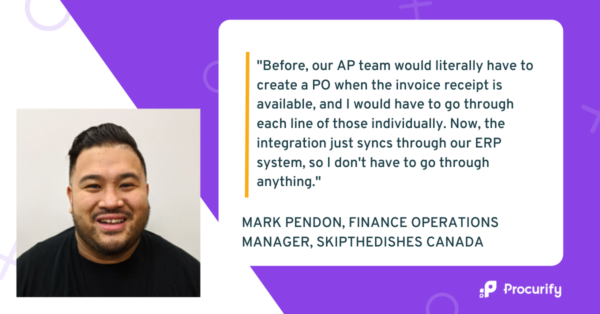Do You Have The Right Finance Role for Your Organization? – John Kasian
Do You Have the Right Finance Role for Your Organization?
This interview is taken from an episode of the Spend Culture Stories podcast.
Having the right finance leader is more critical than ever in these uncertain times. In this episode, John Kasian, Director of Operations at Signature Analytics breaks down the ‘who does what’ in key finance leadership roles and also gives some easy-to-follow tips on the best internal control practices that every venture-backed company should know.

Speakers: John Kasian, Director of Operations, Signature Analytics
John successfully navigates the gap between client service and internal operations at Signature Analytics, and is a people, process and technology expert in the accounting & finance industry specializing in lower-middle market businesses.
Signature Analytics is an outsourced fractional CFO and accounting firm, providing a custom approach to onsite accounting, financial, and business advisory services.
Listen to the Episode Here:
Listen to Spend Culture: Stories of CFOs and Company Culture
Notable Quotes:
What are the key differences between the finance and accounting leadership roles? What are technically the differences between a finance vs accounting leader?
[14:56] An accountant is the scorekeeper. You know, they are the ones on the scoreboard, whereas the finance team is putting together the team schedule and what’s going to happen next. So it’s a tough thing to balance. And, you know, you really need a unique resource to be strong at both.
So typically my recommendation is that you want to have different people be in charge of accounting and then another to be in charge of finance.
And, you know, working with a lot of controllers and finance people is that I’ve realized is that a lot of folks can do both, but not at the same time.
That’s another thing since we work in a fractional environment – If I put two controllers on a job, I could have one of them run the finance operation while the other runs the accounting operations, because they both have the skill sets to do so. But having the same person do both is really difficult.
When you think is a good time for small, medium businesses to start incorporating this kind of strategic finance leader? When you think it’s too late or too early?
Most People Bring in a Leader Later On
Great question. Typically, we run into the most clients that are doing it perhaps a little later than they hoped – and that’s just because they’re busy. They’re trying to get that product to market, they’re rapidly expanding, and they just didn’t really have time or have the ability to take the time in order to make this decision. So usually we see it a little late.
I think the right time to get someone like this involved is when you decide for example: ‘hey, we need to be bankable in about, let’s say, six months to a year.’
Having Clear and Consistent Financials is Key to Be Bankable
I think you need at least that six months to a year lead time to be bankable. And that’s a big component of it. The banks like to see consistent history. They like to see financials that are up to industry standards. And you can’t just do that overnight.
Accounting is is a form of repetition, a sport. It’s a process. You can’t turn it off and on when you choose to. You really have to have some consistency to it. And the more consistent your financials are, the more a bank can give you more resources, like your first line of credit – that’s a huge step for a business.
If you want to become bankable, you need to say, ‘hey, within a year, I want to be able to get a line of credit. I need to get my finance and accounting in order. Now, that’s a critical juncture. And then again, if you’re trying to get additional investment, you need the same type of attitude. You need consistent financials, a plan, and a great finance person. If you’re trying to get an investment, you need to be at least a year out on your thinking.
I know you work with a lot of earlier stage biotech companies where they have a lot of money being spent, either indirect costs or indirect costs when it comes to contractors, supplies etc.
When it comes to spend management and purchasing, what are some bad practices that you’ve seen that are no longer scalable?
Bad practices? Yes, I’ve seen a lot of them. If you’re in early-stage startup, you’re basically a giant checkbook. Let’s say you closed a series A of $20 mil, and you hope that that last you 12 months. You now have a large sum of money in your bank account. You might have a goal for example, that ‘we need to get this product to trials by X amount of time.’
And how are we gonna get there? So usually what will happen is they’ll be rapidly hiring and then there will also be a lot of contractors involved, as you talked about.
1. Lack of a Consistent Cash Flow Statement
So some of the bad practices I see is that there’s not a weekly cash flow and there’s not a monthly or annual cash forecast. Those things are super critical. Companies need to know their burn rate when again, you’re a giant checkbook and you’re not bringing in any cash.
You would think that in order to get the funding, these things would be in place, but that’s not necessarily always the case. I think one having a cash flow forecast weekly where each week: you’re updating what our bank balances is, reconciling the prior week outflows and then projecting the current week’s accounts payable. And then rinse and repeat for the next 13 weeks, (usually we recommend a 13 week period)
2. Not Clearly Understanding Your Burn Rate – No Visibility to Overall Spending
Your burn rate is critical. Understanding what the overall spend for a specific part of the project is critical. So these are difficult and time-consuming finance activities that need to be looked at. Do we need to start our next round of funding sooner? All of those types of things. It has to be a weekly activity.
3. Not Having A Purchase Order System in Place
There’s a lot of materials that need to be purchased, especially in biotechs. So what usually happens is there’ll be a couple corporate credit cards and folks are just spending their swiping constantly. Buying things. Buying component parts, sometimes expensive, sometimes overseas transactions.
So there needs to be a purchase order system in place. Otherwise, there’s a tremendous risk of embezzlement or even just negligence in terms of ordering something twice when you only needed it once.
Those types of things are rampant in biotech startups.
4. Rampant Credit Cards Gone Wild, With No Purchase Orders or an Approval Process
Again, we need to have a chain of command so we like to limit the amount of purchasers. I think that that’s an important part of it. The next part is you want to have a P.O process. So whether that’s a purchase ordering solution like Procurify, you need to be able to trace it from order to invoice to payment. That way, all of those things are tracked. Again, you’ll have a lesser chance of fraud or just ordering duplicates that will go down significantly.
5. You’re Not Working with Credit Card Company to Tokenize Vendors
If you have a succinct purchase ordering process, the next practice that we would recommend that we’ve seen as of late is working with your credit card company to tokenized your vendors.
So essentially tokenizing your vendors allows you to setup with your credit card a token for any of your preferred or common vendors. That way, if your purchase order person is buying things that they shouldn’t be buying, the transaction isn’t going to go through. So that’s another way to gain control your spend in these early stage startups.
Cash is king, so you can’t afford any waste, fraud and puzzlement. Whatever it is, you just can’t do it because you’re not collecting. You won’t be able to recover as easily from these loose practices as a company that’s productized.
Why is it so important to utilize purchase orders? (For those companies who aren’t using them right now)
Sure. Purchase are important from an internal controls standpoint. We need to make sure we’re not buying duplicate goods. It’s also good from an organizational standpoint.
Let’s just say a company that’s ordering a lot of supplies, they’re moving very quickly. So what can happen is you can be ordering goods. Then you’re also receiving goods when you have the P.O, can confirm that you’ve ordered 500 of this particular item. And then when you receive only 400, you know that you still have 100 open on the P.O.
POs Catches Missed Orders and Line Items
If you’re not using a P.O process and when you’re receiving, you kind of don’t really know necessarily how much you should be receiving. Should it theoretically be on the invoice for purchase? Sure. But you just eliminated one of the internal controls part of the receiving process by not having this P.O, so you could be short shipped something, but you don’t really know because you don’t have this piece of paper that tells: ‘Oh! We were supposed to get X amount of these.’
So it’s really critical when you’re dealing with hardware, inventory, etc. Any type of thing that has to do with tracking components. I’d say it’s always best practice to have a P.O and then have your shipping and your receiving report.
POs Prevent Duplicate Orders or Fraudulent Orders
And then you know, once those goods ultimately get there, you want to relieve those from your PO and say, hey, we’ve received these items. So it’s a critical internal control process.
I think what you’ll see when you don’t have POs, is that no one really knows the amount of goods orders. No one knows if they’ve received everything, or there’s still items outstanding – there’s just a lot of ambiguity to that.
That can result in the duplication of purchases and then you’ll have the wrong amount of things. You’ll overbuy. You’ll want to buy anything in between. So that’s one of the big benefits of having a PO.
POs Allow a Pre-approval Process In Place Before it Goes to a Finance Role
And one of the other things is that, you know, then at least there’s a process before the purchase actually happens. So you’re not just swiping the credit card for the invoice. You know that it’s going through an approval workflow. So I submit a purchase order, it’s reviewed by my manager and then, you know, the purchase order is then submitted to the vendor. You can also add in an approval step in the workflow, which if you have a lot of lower-level employees that need to make purchases. That’s something that you’ll definitely need.
Read How Skip the Dishes Saves Hours in Their Requisition and Invoices Processes with Procurify

About the Podcast:
Your company culture might attract talent, but your Spend Culture will make or break your company. The Spend Culture Stories podcast helps finance and operations leaders learn the tactics, strategies, and processes to build a proactive Spend Culture.
In this podcast, we have human conversations about the messy and sometimes hilarious stories that happen when people, organizations, and money meet. Learn how to pick the right tools, implement the most efficient processes, and how to develop the right people to transform the Spend Culture of your organization for the better.
Listen to Spend Culture: Stories of CFOs and Company Culture
